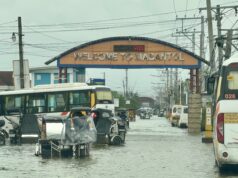Should a strong earthquake like the one that happened in Dumaguete City and nearby provinces will hit Davao City soon, are you prepared?
“God forbid” was what Sarah uttered and then made a sign of a cross when posed the question above.
Perhaps no other natural disaster can cause so much damage so suddenly and in so little time as earthquake.
It is surprising that nobody wants to talk about it in the earthquake-prone Philippines.
“It’s one issue that most Filipinos don’t talk about or do something about,” points out Roy C. Alimoane, director of non-government organization who has already experienced several earthquakes in his life. “Until it’s too late. Earthquake is one issue that we should not avoid but confront head-on.”
People talk about earthquake only when such disaster hits. Such was the case of the 6.9-magnitude earthquake that struck Visayas and some areas of Mindanao and Luzon before noon last February 6.
In the badly-hit Negros and Cebu provinces, more than 50 people perished and several others missing. It also caused landslides and huge cracks on highways.
“A three-story building collapsed, while seven bridges were rendered impassable,” reported Philippine Daily Inquirer.
“Rescuers dug with picks and shovels trying to reach dozens of people trapped under houses collapsed by a strong earthquake Monday that shook a central Philippine island,” said a dispatch released by the Associated Press.
About 90 percent of the world’s earthquakes and 89 percent of the world’s largest earthquakes occur along the Pacific Ring of Fire.
In a 40,000 kilometers horseshoe shape, this basin of the Pacific Ocean is associated with a nearly continuous series of oceanic trenches, volcanic arcs, and volcanic belts and/or plate movements.
The circum-Pacific belt – as it is sometimes called – has 452 volcanoes and is home to over 75 percent of the world’s active and dormant volcanoes. Unfortunately, the Philippines is situated in the so-called ring of fire.
This explains why the country is often visited with earthquakes.
“Almost every year, the Philippines is visited by two or more earthquakes,” said an official of the Philippine Institute of Volcanology and Seismology (Philvocs), the line agency of the Department of Science and Technology dedicated to provide information on the activities of volcanoes, earthquakes, and tsunamis.
In fact, earthquakes occur daily in small scales in the Philippines, according to Dr. Renato U. Solidum, the director of Philvocs. In January 2011, for instance, a total of 87 earthquakes occurred in various parts of the country.
The strongest was a magnitude-5.9 that occurred 55 kilometers northeast of Mercedes, Eastern Samar on January 17 at 8:55 p.m. Earlier on that same day at 6 p.m., a 5.1 magnitude tremor hit an area 29 kilometers northeast of Don Marcelino, Davao del Sur.
The next strongest was a magnitude 5.5 that hit 62 kilometers southeast of Virac, Catanduanes on January 28 at 8:17 a.m. At noon on that same day, a 5.0 earthquake occurred at 38 kilometers northwest of Calayan, Cagayan.
Another 5.5 quake occurred 41 kilometer northwest of Calayan, Cagayan on January 15. Other quakes of the scale of magnitude 5 were: 5.0 that hit 10 kilometers southwest of Talacogon, Agusan del Sur on January 12; 5.0 at 103 kilometers southwest of Sarangani, Davao del Sur, and 5.3 on January 24 at 8 kilometers northeast of Barobo, Surigao del Sur.
Little was understood about earthquakes until the emergence of seismology at the beginning of the 20th century. Seismology, which involves the scientific study of all aspects of earthquakes, has yielded answers to such long-standing questions as why and how earthquakes occur.
“About 50,000 earthquakes large enough to be noticed without the aid of instruments occur annually over the entire planet,” wrote Bruce A. Bolt in Encyclopædia Britannica.
“Of these, approximately 100 are of sufficient size to produce substantial damage if their centers are near areas of habitation. Very great earthquakes occur on average about once per year. Over the centuries they have been responsible for millions of deaths and an incalculable amount of damage to property.”
Earthquake, a naturally induced shaking of the ground, may result fro flood-caused landslides, the impact of a particularly heavy object from the outer space such as a giant meteor on the earth’s surface, or nuclear explosions.
For the most part, however, earthquakes are caused by movements and increase in stress, deep within the bowels of the earth.
Stress may be built up over a long time, until the pressure causes subterranean rock plates to fracture or slip along a fault line.
Faults are breaks or zones of weakness in rocks along which displacements had occurred or can occur again.
They may extend for hundreds of kilometers downward, even down to the base of the so-called lithosphere.
Faults showing signs or documented history of recent displacements are called active faults.
The Philippine Fault, which runs from north to south of the country, is an active fault. Other faults in the Philippines include the Digdig Fault, Casiguran Fault, Lubang Fault, Tablas Fault, and the Mindanao Fault.
Earthquakes also occur in trenches or those deep, narrow cuts under the ocean. The Philippines is unfortunate to have two long trenches: the Philippine Trench in the east and the Manila Trench in the west.
Other trenches include the East Luzon Trench, the Negros Trench, the Sulu Trench, the Cotabato Trench, and the Davao Trench.
Shaking at the site of the earthquake lasts only during the time when the fault ruptures, a process which takes seconds or at most a few minutes.
The seismic waves or vibrations generated by the rupture continue to propagate after the movement of the fault has stopped, spanning the globe in 20 minutes. This is called an aftershock, an earthquake that occurs after a previous earthquake.
Only in the immediate vicinity of the fault, at the earthquake’s epicenter, are these vibrations powerful enough to cause damage. Epicenter is the point on the earth’s surface directly above the origin, or focus, of the earthquake.
At the earth’s surface, earthquakes manifest themselves by shaking and sometimes displacement of the ground.
When the epicenter of a large earthquake is located offshore, the seabed may be displaced sufficiently to cause tsunamis or tidal waves. With a height up to 50 feet, these waves can cross an ocean in several hours, inflicting damage upon shores far from the earthquake itself.
“The only way to avoid disasters caused by earthquakes is to prepare for them,” suggests Maria Elena Paterno, award-winning author of Earthquake.
Words of wisdom, these.



